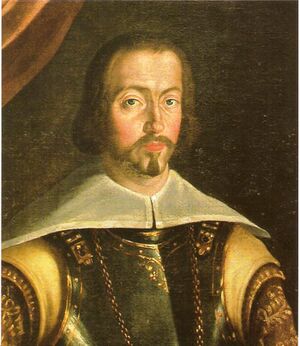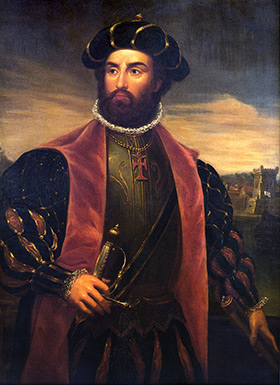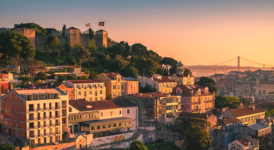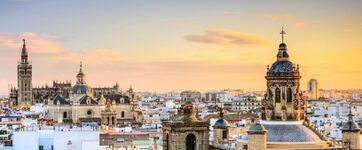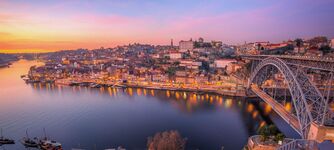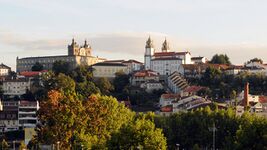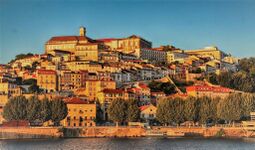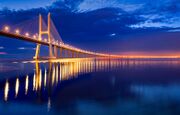Produzland
This article is incomplete because it is pending further input from participants, or it is a work-in-progress by one author. Please comment on this article's talk page to share your input, comments and questions. Note: To contribute to this article, you may need to seek help from the author(s) of this page. |
Kingdom of Produzland [a] O Reino de Proádusia | |
|---|---|
Motto: "Nos Sustinere." | |
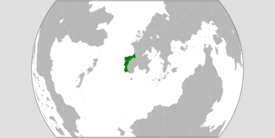 Official map of the Kingdom of Produzland | |
| Capital | Burlon |
| Largest city | Burlon |
| Official languages | Produese |
| Recognised regional languages | Produese, Cabecan, Aenian, Cadasan |
| Ethnic groups (2011) | Produes 90.58% Cabecans 3.63% Others 6.79% |
| Demonym(s) | Produes, Produese |
| Government | Parliamentary Constitutional Monarchy |
| Riccardo Bonadeo, PdP | |
| Legislature | Tribunais Gerais |
| Senate | |
| Congress of Deputies | |
| Kingdom | |
• West and East Aenicia Split | May 29th, 887 |
• Cavale and Galicia Split | March 4th, 987 |
• Establishment of the Kingdom of Cavale and Galicia | February 19th, 1140 |
• De Facto Establishment of the 2nd Kingdom of Produzland | June 20th, 1308 |
• De Jure Establishment of the 2nd Kingdom of Produzland | January 15th, 1715 |
• Establishment of the 3rd Kingdom of Produzland | January 12th, 1925 |
• Established of the Federal Republic of Produzland | July 16th, 1928 |
• Establishment of the 4th Kingdom of Produzland | February 18th, 1980 |
| Population | |
• 2019 estimate | 61,432,763 (20) |
• 2019 census | 61,432,763 |
| GDP (nominal) | estimate |
• Total | 627,875,000,000 |
• Per capita | 10,220 |
| Gini (2011) | 34.67 medium |
| HDI (2011) | 0.781 high |
| Currency | Rozar (ROZ) |
| Date format | mmddyyyy |
| Driving side | right |
| Calling code | +55 |
| Internet TLD | .prd |
Produzland, officially, the Kingdom of Produzland (Produese: O Reino de Proádusia), is a sovereign state in Greater Olympus. Produzland is located on the western half of the Orthurian Peninsula in Southwest Lira. Produzland borders the Aurum Ocean in the west, and Meronnia in the North-East, as well as Parthonopia in the east. The Kingdom covers an area of XXXX square kilometers with an oceanic and mediterranean climate. It is a parliamentary constitutional monarchy with 38 million inhabitants (2014) and King Joseph III as king since 2019.
Around 455 a group of people known as Aenians invaded the Orthurian Peninsula, the Aenians were called the "Produese" as they moved to the Orthurian province of Produsia. The lands that are now Produzland was a province of the Orthurian Empire called Produsia until the 400s when 2 nations emerged from Produsia, Aenícia, and Calmatia. West Aenícia split from Aenícia to become Cavale. After the division of Calmatia over the course of the middle ages Cavale conquered most of Western Orthuria and became the successor state to Produsia. After a history of imperialism and many royal dynasties, the empire was dissolved after the devastating Olympic War. This resulted in a dictator seizing control of Produzland in 1928 and annexing Cabeca in 1937. The dictatorship was removed in 1980 with the monarchy being restored and Produzland growing now being a main producer of trains, seafood, and luxury items.
Produzland is ones of the leading countries in seafood production and luxury items with companies like Calmatia and Ludovico, Venâncio, Gárcere, Rego-Dalgarno Hotel Company, and Vítor Loureiro. Manufacturing is the dominant force in the country with significant contributions from refining. The parts made in Produzland are both exported and made into finished products, though the economic goal of the nation is to export the majority of parts out of the country, while keeping/importing some parts for local manufacturing before exportation. Imports include raw materials as well as finished goods and services from other countries. The resources on hand and the priorities of Produzland influence what type of refinement and manufacturing will take place. Produzland's manufacturing specialties include Train Engines, Train cars, and electrical equipment.
Etymology
The Aenians referred to western Orthuria as "Proáducia" after the Aenian word for carrots. The Orthurian Empire took that name and named their westernmost province Produsia, which would evolve into Produzland in Lorian. The state that is now Produzland was originally called The Kingdom of Cavale & Galicia until the de facto Kingdom of Produsland began with King Henry I being placed on the Cavalian and Aenicioan throne. This became de jure in 1715 with the West Bresbon Decrees.
The standard way to refer to a citizen of Produzland is as a "Produe."
History
Early History (-490)
The Orthurian Empire had owned the region now known as Produzland until the Aenian people of northern origin were migrating throughout northwest Orthuria, they set up multiple kingdoms in the north under Aenian control, the most prominent ones at the time being Galicia, Aenicia, Sundrescia, and Kabesca. The Orthurians borrowed the Aenian name for the whole region of west Orthuria to become the official name of the province, Produsia.
Aenicia and Calmatia (490-879)
Under the rule of the Orthurians two main people groups rose to prominence in the west, the Aenians and Calmatians. With the fall of the Orthurian Empire over the course of the 5th century, the two people groups had set up their respective domains. Unlike the Aenians mentioned earlier, the Calmatians formed a unified state in the south comprising territory even north of the Mazarico River, where they took the great city of Olivrium from the Orthurians. During the 6th, 7th, and 8th centuries the Aenians had unified under one country, the Kingdom of Aenicia, while the Kingdom of Calmatia fractured into multiple states including the Kingdom of the Rodaves, the Kingdom of Selcear, and the Kingdom of Cadascun, however at the time the three kingdoms all spoke Cadasan, now known as Southern Produese.
West Aenicia (879-987)
Due to a succession crisis in Aenicia in 879, a country that had become the dominant Aenian country of Orthuria, the country was divided into West Aenicia and East Aenicia, the former being ruled by the bastard son of King Alfonso II of Aenicia, Ferdinand and the Galician House of Fonseca, and the latter ruled by Alfonso's legitimate son Vicente and the already Aenician ruling House of Outeiro. West Aenicia and East Aenicia both held large chunks of territory from Aenian expansion southward since the beginning of the middle ages, East Aenicia held the old united capital of Relâpago, while West Aenicia originally made Arencia the capital of the new country.
Second Split of Crown (997-1140)
The crown of West Aenicia split in 997 after the death of Ramiro II of West Aenicia, he split the country into north and south, the north known as the Kingdom of Galicia, a historical name for the region, ruled by his brother Alfonso III, the south took the name "O Reino de Cavela", or the Kingdom of Cavale ruled by Ramiro II's cousin Ferdinand III.
The Kingdom of Cavale and Galicia (1140-1308)
The crowns of Cavale and Galicia unified again under King Peter I of Cavale and Galicia. This nation state would become the leader of Produese unification and the predecessor state of Produsland. During this period the country is often referred to as simply Cavale.
Produese Wars of Unification (1267-1308)
In 1267, tensions were high between the neighboring countries of the Kingdom of Cavale and Galicia and the Kingdom of Cadascun that recently took over the County of Cojazeira from the Rodavese, which would eventually finally be set off when Cadasan king Alfonso VI died in battle against the Selçénese in the Battle of Mergulhe-O-Grande. Cadascun was terribly unprepared to replace the king with 3 month old Prince Henrique of Calmatia, which gave Cavale the perfect chance to take over Anavede and all the south bay area, currently under Cadasan rule, and perhaps even all of the Kingdom of Cadascun. So in the summer of 1267, the Cavallian forces crossed the Ivreana River into Cadascun. Already dealing with internal issues, Cadascun was easily defeated and swept aside at Anavede, Gretia Novo, and Azevedo, until King Vicente II himself and his army arrived at the walls of Cadascun capital, Portuaria. Realizing the city and it's people could be eliminated, the Cadasans surrendered. Cavale and Galicia welcomed the Cadasans into the kingdom and poured heavy amounts of money into rebuildings northern Cadascun.
In the 13th century the Kingdom of Velarre and the Aenician Duchy of Sundrescia had been in fierce competition over Cabeca. Velarre forming out of the Kingdom of Lurrak in the 1100s. While Sundrescian was Aenian as opposed to Cabecan like Velarre, they still vied for power in the region ever capturing the city of Lurrak itself, renaming it to San Aurelio after the Saint Aurelius.
In 1301 began the War of the Thymes, which with the help of Philip III the Vain and the Sundrescians put Henry I, Count of Lugo on the throne of Aenicia and Cavale in 1308, leaving the two as independent kingdoms under one monarch. At this point they were practically united however. This began the de facto Kingdom of Produsland.
Early Produese Empire (1486-1550)
The Produese Empire slowly began to form when King Ferdinand VIII inherited both the Eskeri territory of Ramyvis and the eastern Ecelean duchies of Korunov and Svetec on the continent, including annexing southern Velarre in 1515. Produese expansion on the continent continued when King Henry III took the Kingdom of Selçéar in 1538 which he quite easily did after shelling Calorbairro, the Selçénese capital from the Produese side of the Mazarico River, ending the 300 rule of the Selçénese House of Nascimento.
Over the course of the 16th and 17th centuries, the Produese Empire expanded it's influence heavily in Nori and it's southeastern islands. The first example in 1513 Aloisian explorer Aleixandre do Orestes became the first Liran to land on mainland Nori, despite failing to colonize mainland Nori, this opened up the gateway for Produsland to become the dominant Liran power in east Nori. 20 years later in 1533 Aleixandre do Orestes and company landed on the Strait of Marque island of Comona, establishing São Diego. Years later another company landed on the mainland and established the colonies of Novo Aenicia and Senãles Alto e Baixo in modern Carelia.
However tragedy struck the King Henry III and he was murdered in a jousting accident, this lead way however to his brother Joseph the Colonizer to revamp the Produese Empire in east Nori with the Produese Gulf Company to become one of the richest nations in Lira, and the House of Lugo one of the richest in the world. Joseph I also officially moved the capital from Lavoeira to Burlon.
Joseph's first major feat in his reign being in 1543 when Jorge Adão da Coutinho landed in southern Kiteahu and established Fort Santa Ângela on an island he called Cavaco. Da Coutinho also landed in the eastern islands of modern Jashnagar a few years later, which he and his fleet gave it the name 'Jaixnágar'.
In 1546 the wealthy Republic of the Rodaves began to collapse and was annexed into the Kingdom of Produsland, ending the century long southern republic.
Vincennine Produzland (1550-1700)
After Joseph I died shortly into his reign in 1550, he was replaced with his son Philip, and through his mother Philip also inherited the Kingdom of Meronnia in 1551 leaving him as King Philip I & IV of Produsland and Meronnia and he one of the most powerful men in history as Produsland continued their colonial reign in east Nori.
In 1559, Miguel João de Leitão and his ship the São Sebastião discovered a lot of the islands in the western half of the Jashnagari Archipelago. The next year in 1560, Captain Domingos Bráulio of Produsland lands on the Ashaheiru Islands south of Zanaro, claiming the islands as Produese territory. Bráulio didn't realize they were part of Zanaro so King Philip of Produsland decided to take them by force if Zanaro wouldn't like them have the islands. They eventually overran the natives and Zanarites from the islands later that year. The islands were used as a Produese naval base under Produese colonial rule.
In 1582 when King Philip died, he split his empire in two with his son Vincent III inheriting Produsland and his daughter Ermelina I inheriting Meronnia and beginning the Meronnian branch of the House of Lugo. The two nations stayed very close allies throughout history though.
In the year 1643 a decade after Produsland's defeat in the 20 Years War, revolts began to spring up in the Rodaves and in Produese owned Cabeca, causing King Vincent IV effectively lose control of the former. Unlike the previous independent Rodavese state, the Rodaves became a kingdom and crowned Louis of the House of Bromista as King Louis I of the Kingdom of the Rodaves.
It was around the mid 1600s that the Lorian word Produsland shifted from Produs-, to the modern word Produz-, there was no real explanation for this shift, it was natural though as Produsland had always been pronounced as "Produzland" with a 'z'.
Beltránian Produzland (1700-1813)
In early 1700 Charles I died childless, following the rules of Produese succession the crown passed to King Louis III of the Rodaves of the House of Beltrán. Louis III would pass however before he could be crowned, leaving the thrones of Produzland and the Rodaves in the hands of his five year old son Prince Vícenç de Beltrán i Portell. Vícenç became Vincent V of Produzland and Vincent II of the Rodaves. However the Kingdom of Parthonopia, a staunch ally of the Rodaves rejected the idea of a personal union between Produzland and the Rodaves, so Parthonopia declared war in 1701. The young king's regent was his uncle Carles, Duke of Sevidiz who responded quickly to the Parthonopian war. However after a couple of major naval defeats in the Rosel Sea Produzland and the Rodaves surrendered in 1709. In the Treaty of XXXX, Produzland gave up the island of Aloisio to become a kingdom in a union with Parthonopia. It also ceded parts of the eastern Rodaves and several other border regions. The border established in the treaty is the one that remains till today between the two countries.
Vincent was formally crowned in Araújo by the Archbishop of Araújo earlier that year at the age of 15. One of his earliest acts was the dissolution of the current feudal system in Produzland, removal of any regional power with the Crown of Aenícia, and formal integration of the Kingdom of the Rodaves into the larger kingdom, all included in the West Bresbon Decrees of 1715. This also de jure established the centralized Kingdom of Produzland.
In 1734, at the age of 39 Vincent V began expanding the borders of Produzland into the regions he saw fit. With an alliance with Meronnia, Produzland and Meronnia invaded the financially struggling Kingdom of Velarre and deposed Louis II. Produzland drove quickly through the Cabecan lands and annexed most of the modern state of Cabeca into the kingdom. Vincent established the new Principality of Cabeca with the lands taken from Velarre and many lands from the Duchy of Sundrescia with Cabecan populations. He then declared the heir to the throne of Produzland would be given the title "Prince of Cabeca".
Continuing the expansion policy Produzland invaded the Kingdom of Aloisio in 1738, kicking off a second war with Parthonopia. However Parthonopia was unprepared and fought sloppily, leading to a massive destruction of the joint Aloisian-Parthonopian army on the island, and the destruction of the Parthonopian fleet in the Rosel. Vincent V declared his second son Philip King of Aloisio as Philip I at the age of 18, as Philip was not directly in line for the throne.
This would change however in 1751 when the king of Produzland and son of Vincent V, Vincent VI died childless. This lead to King Philip I of Aloisio being crowned King Philip II of Produzland as well. He fully integrated Aloisio into Produzland the next year.
The beginning of the end of the Produese colonial empire truly began a few years later when in the Strait Wars with Velkanika, the colonies of New Aenicia and Senales were awarded to Meronnia that had the Lugos out of power not to long beforehand. Another reason was for the powerful Produese Gulf Company began hoarding collected money away from the government and into the company itself and it's owners. An effect of that being in 1798, King Philip II sold the island of Comona to Carelia for a large sum of money. Following the action, Philip II's final act as king of Produzland would be the Produese Gulf Company dissolved.
Great Continental War (1808-1818)
Prince Carlos, the grandson of Philip II inherited the throne after his grandfather's death in 1801, becoming Charles II. Due to pressure from the parliament, Charles II had Produzland side with Augustin in the Great Continental War. This alliance was turned on its head in 1813 however when Augustin invaded Produzland and deposed King Charles. Conveniently Charles did not have children and would pass in 1814. Augustin put his brother Francis on the throne of Produzland who became Francis I. King Francis took his rule to heart and attempted to understand his people, even taking the time to learn Produese. However this sadly didn't deter the people as they rebelled against the monarchy, rallying behind Carlos de Boaventura, a nobleman from a small southeast city that happened to be the second cousin once-removed of the King Charles II. The Produese people engaged in fierce guerilla warfare against their Meronnian occupiers. When Augustin was defeated and the Meronnians pushed out the country, Produzland put Carlos de Boaventura on the throne as Charles III.
Late Produese Empire (1818-1925)
The first major thing Charles accomplished on his throne was the signing of the Compromise of 1819, revoking the noble titles of the component realms.
In 1893, the Cavo-Carelian War began over the control of several islands in the area that previously Produzland owned for years. The Cavo-Carelian War was short and ended with a Carelian victory and Carelia seizing all Produese islands in the strait because of the declining power of Produzland and a very poor empire that hd been developing for years.
In 1900, King Vincent VIII of Produzland died leaving his grandson Carlos IV to become king at 17. Carlos IV though became increasing paranoid as the last century Produzland seemed it would have a revolution to get rid of the absolute power of the monarchy, seeing what happened to his first cousin twice removed, and the prime minister Alexandre Coelho of Produzland was encouraging the parliament to take down some of the monarchy's power, Vincent VIII. Carlos IV did not want this happening to him and his successors as not only was Coelho planning to bring down the monarchy's power. To his advantage though, Coelho was voted out of power in the 1900 election and replaced with a firm monarchist prime minister, Filipe de Estavao.
In 1898, the War of Parthonopian Succession occured invloving Produzland, and the empire obtained Cisparrania, and Subparrania was turned into a puppet state of he empire.
Olympic War (1913-1925)
(Insert OW and formation of the 3rd Kingdom of Produzland)
Post-Olympic War and Produese Revolution (1925-1928)
After the war, a man named Frederico Deusto, a former sharpshooter that served in defending Costas do Vermelho gained influence in his home town of Cojazeira beginning what would be his rise to power to Prime Minister.
Deusto Era (1928-1980)
Cabeca was made an independent republic after the Olympic War, however Deusto wished to get the region back and annexed the republic in 1937, however most Cabecans, with Produese rule still fresh in their minds accepted the invasion and integration as a Produese state.
Restoration of the Monarchy (1980-)
In 1979, the Produese dictator passed, hoping his legacy would live in and his party would find an appropriate successor once the National Union Party won again. However with the figurehead of the party gone, and the fear of not voting for National Union was gone, National Union failed to win the most seats in Parliament, losing the Monarchist Party lead by Ronaldo Antunes, how became President. However with his new found power he shifted Produzland's government democratic and held a referendum to restore the monarchy. The people had chosen to restore the monarchy and Antunes chose Daniel de Boaventura, a grandnephew of Charles IV and Ferdinand IX to become the first monarch of the new found 4th Kingdom of Produzland. It's been that way for almost 40 years now and today Produzland is still a leading country in Lira importing Bauxite and exporting aluminum and manufactured goods.
Government & Politics
Produzland is a parlimentary constitutional monarchy. The Constitution grants the division or separation of powers among four bodies, the King, the Government, the parliament, and the Courts. The constitution of 1773 also states that the capital of Produzland is always in the city of where the monarch lives.
The king of Produzland is King Joseph III. The Produese parliament is elected through the states electing how the six parties represent their respective seats in the parliament there being 100 seats in the house and its divided by what percentage of that state's population takes up the whole Produzland. For example Oestebaia has a population of 7 million out of the 38 million giving it 14 seats of 100. (Any extras not making 1 whole is given to the smallest state in the country, which occasionally gives the least populated more seats than the 2nd least). The seats per state is appropriately adjusted every 4 years. The 6 parties are represented by the 6 main colours (red, orange, yellow, green, blue, purple), and the colour is represented by a party campaigning for a spot of the 6 colours every 5 years, though normally it's always the same parties winning, the last change being Orange who is now represented by the far right party FPGN after replacing the mildly conservative NDML in 2010. And so the states decide how they want their appropriate seats divided amongst the 6 parties. The Prime Minister however is just elected through polls in the 19 states out of the 6 party leaders every 5 years, the newest change being in August of 2018 where Riccardo Bonadeo replaced Agostinho Valdez.
Foreign Affairs
Military
The armed forces have three branches: Navy, Army and Air Force. They serve primarily as a self-defense force whose mission is to protect the territorial integrity of the country and provide humanitarian assistance and security at home and abroad. As of 2008, the three branches numbered 390,200 active personnel including 7,500 women. Produese military expenditure in 2009 was billion, representing 2.1 percent of GDP. Military conscription was abolished in 2004. The minimum age for voluntary recruitment is 18 years.
The Army (105,000 personnel) comprises three brigades and other small units. An infantry brigade (mainly equipped with Pandur II APC), a mechanized brigade (mainly equipped with Leopard 2 A6 tanks and M113 APC) and a Rapid Reaction Brigade (consisting of Paratroopers, commandos and Rangers). The Navy (50,700 personnel, of which 5,580 are marines), has five frigates, seven corvettes, two submarines, and 28 patrol and auxiliary vessels. The Air Force (155,500 personnel) has the Lockheed F-16 Fighting Falcon and the Dassault/Dornier Alpha Jet as the main combat aircraft.
In addition to the three branches of the armed forces, there is the National Republican Guard, a security force subject to military law and organization (gendarmerie) comprising 25,000 personnel. This force is under the authority of both the Defense and the Interior Ministry.
Geography
Produzland is located in south-west Lira, and is bordered by the Aurum Ocean in the west and the Rosel Sea in the south.
The Marine West Coast or Oceanic Climate of Produzland has a very mild climate lacking in extreme temperatures. It typically lacks a dry season, as precipitation is consistent throughout the year. Summers are cool due to cool ocean currents, winters are mild usually very cloudy. With Summers below 22 °C (72 °F) and winters above −3 °C (27 °F).
The Mediterranean climate in the south of Produzland is characterized by dry summers and mild, moist winters. The average temperature is above 10 °C (50 °F) in their warmest months, and an average in the coldest between 18 to −3 °C (64 to 27 °F). The climate receives almost all of its precipitation during the winter, autumn and spring seasons, and may go anywhere from 4 to 6 months during the summer without having any significant precipitation.
Population
Largest cities or towns in Produzland
2014 Tri-annual Census Produese Bureau of Population Statistics (GPEP) | |||||||||
|---|---|---|---|---|---|---|---|---|---|
| Rank | State | Pop. | |||||||
| 1 | Burlon | Burlon | 5,946,071 | ||||||
| 2 | Cartaganca | Rodaves | 3,207,563 | ||||||
| 3 | Luville | Miragaia | 2,702,365 | ||||||
| 4 | Portuária | Portuária | 2,417,539 | ||||||
| 5 | Delgado | Galícia | 2,153,067 | ||||||
| 6 | Cojazeira | Almúnia | 1,520,207 | ||||||
| 7 | Biscegona | Cabeca | 940,121 | ||||||
| 8 | Maleta | Turão | 695,562 | ||||||
| 9 | Bresbon | Agudicia | 419,673 | ||||||
| 10 | Calorbairro | Selará | 276,349 | ||||||
- San Aurelio.jpg
Skyline of São Aurélio.
Economy
Produzland has a Refining/Manufacturing Economy with both lower and higher secondary sectors. Manufacturing is the dominant force in the country with significant contributions from refining. The parts made in Produzland are both exported and made into finished products, though the economic goal of the nation is to export the majority of parts out of the country, while keeping/importing some parts for local manufacturing before exportation. Imports include raw materials as well as finished goods and services from other countries. The resources on hand and the priorities of Produzland influence what type of refinement and manufacturing will take place. Produzland's manufacturing specialties include train Engines, train cars, and electrical equipment.
Transport
Continental Produzland's territory is serviced by six international airports located near the cities of Portuaria, Lavoeira, Burlon and Oraveira. Burlon's geographical position makes it a stopover for many foreign airlines at several airports within the country. The government decided to build a new airport outside Burlon, to replace Burlon Portela Airport, though this plan has been suspended due to austerity measures. Currently, the most important airports are in Burlon, Portuaria, Aloisio (Aloisio Ilhas), and Oraveira, managed by the national airport authority group ANA – Aeroportos de Proadusia.
The major seaports are located in Lavoeira, Cartaganca, Casocuse, Portuaria, Viosinho, Depice, and Biscegona.
The three largest metropolitan areas have subway systems: Lavoeira Metro and South Anavede Metro in the Lavoeira Bay Metropolitan Area, Burlon Metro in the Burlon-Araujo Metropolitan Area, and Cartaganca Metro in the Cartaganca Metropolitan Area, each with more than 35 km (22 mi) of lines. In Produzland, ónha tram services have been supplied by the Southwest Transport, for over a century. In Portuaria, a tram network, of which only a tourist line on the shores of the inner city remains, began construction on 12 September 1895 (a first for the Orthurian Peninsula). All major cities and towns have their own local urban transport network, as well as taxi services.


